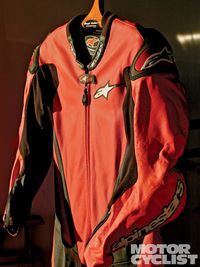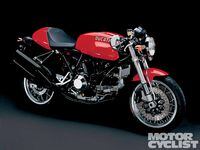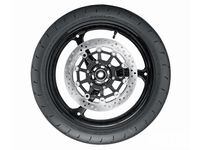Got a question for answers? Send it to mcmail@sourc.com.com
Well-Weathered Leather
Q: I have a seven-year-old set of Alpinestars leathers that have been spending more time hanging in the garage these days than running around the track. But aside from worn-out knee sliders and an embarrassing layer of dust, they look pristine. My high-school baseball glove still works as well as ever, so I'm hoping this cowhide should have a good bit of life left in it as well. Am I right? How about the body armor? Helmets have to be replaced every few years; how about the armor in a good set of leathers?
Aside from hanging the leathers under a cover on the original hanger, what else should I be doing to protect my investment? The suit still fits perfectly. Buying a new one is pretty much out of the question right now. It's hard enough to scrape together enough coin to finance the occasional track day!
Jerry Nuss
Halifax, NC
A: _Sounds like you're good. According to Tim Collins at Alpinestars USA, a properly stored leather suit like yours that's been kept inside a garage and spared any extreme temperature changes should keep for several years. It will still offer good protection, assuming it's never actually hit the pavement at speed and all the seams and panels look okay. Cracks may appear as the leather ages, but don't worry. "Little cracks in the surface finish won't affect safety or performance. They should be considered normal, especially on a suit that was left untouched for so long," Collins says. The same holds true for the armor: "Impact protection should be adequate after several years assuming the suit wasn't exposed to very high or low temperatures, especially extreme heat, which can weaken the foam."
A thorough inspection is highly recommended. "If you doubt the condition of any protective pieces, replacement armor should be installed," Collins adds.
_As far as cleaning goes, here's the drill: Start by going over the suit with a soft brush to remove dust, especially from seams and debossed areas. Low-pressure compressed air-no more than 2-3 psi-helps as well. Then give it a good once-over with high-quality leather cleaner-the same stuff you might use on leather sofas or car seats. Pay extra attention to areas that may have been stained by greasy/oily stuff. Finally, apply a good leather protection cream-we've had good luck with Leather Master products-to keep everything supple and prolong the life of the suit.__
Dimpled Duck
I have a 2006 Ducati Sport Classic 1000. Its first fuel tank swelled so badly that it came out of the frame stays, and was dimpled/pimpled down the right side. Ducati replaced that one in April of 2008, and now the new one is swelling, more on the right side than the left. Aside from aesthetics and resale value, I'm concerned about safety. Some blame gasohol, aliens or the Obama administration. I'd like to know what caused this, and what I can do to stop it.
Gary Bird
Champaign, IL
We've ruled out extraterrestrial involvement along with any sub-rosa intervention from the Obama White House. Beyond that, most explanations of the underlying pathology are long on speculation and skimpy on specifics. Still, some component of your fuel is infiltrating the plastic tank material, inducing unsightly swelling, dimples and pimples. Thankfully we're not talking about all Sport 1000 tanks, or even most. Ducati North America says it's a supplier problem. They'll take care of it whether the original warranty is in force or not. Just get the bike back to your dealer. They'll snap a picture of the afflicted tank, send it to the home office and install a new one for you post-haste.
FAQ
Follow the Arrow
Q: Why are motorcycle tires directional? Is it purely for water evacuation or is there some other, less obvious reason?
A:_ The tread patterns on most modern high-performance street tires work better rolling in one direction than the other. The front is optimized for steering and braking; the rear for putting down power. Pumping water away from the contact patch is another facet, as noted, but there's another reason to heed those directional arrows: The rubber that is now your tread started out as a long, flat strip before being vulcanized to the carcass and joined with a diagonal splice. More contact area makes said diagonal joint stronger because, when mounted correctly, predominate rotational forces push the joined ends together instead of trying to pull them apart. Since most of the braking forces are applied through the front tire, that splice runs in the opposite direction of the one on your rear tire. If you were to use the same tire at both ends and the arrow only indicated the drive direction for the rear, it would be best to mount the front so that it spun the other way. _















/cloudfront-us-east-1.images.arcpublishing.com/octane/QCZEPHQAMRHZPLHTDJBIJVWL3M.jpg)
/cloudfront-us-east-1.images.arcpublishing.com/octane/HXOUJXQWA5HBHGRO3EMJIGFMVI.jpg)

/cloudfront-us-east-1.images.arcpublishing.com/octane/3TIWWRV4JBBOLDVGRYECVVTA7Y.jpg)
/cloudfront-us-east-1.images.arcpublishing.com/octane/KIX5O23D5NAIBGFXBN3327DKZU.jpg)
/cloudfront-us-east-1.images.arcpublishing.com/octane/7GJYDUIPXRGMTMQKN6ONYOLBOU.jpg)
/cloudfront-us-east-1.images.arcpublishing.com/octane/MUQLOVLL2ZDGFH25ILABNBXKTI.jpg)
/cloudfront-us-east-1.images.arcpublishing.com/octane/TNOU5DNE2BC57MFPMGN2EIDXAM.jpg)
/cloudfront-us-east-1.images.arcpublishing.com/octane/GTCXACQGJ5HAPDTGWUQKDEH44E.jpg)
/cloudfront-us-east-1.images.arcpublishing.com/octane/S35YGSEMEZB4BLTDJTSZPF4GLA.jpg)
/cloudfront-us-east-1.images.arcpublishing.com/octane/5UOT6HPX2JFMRJAX6EH45AR4MQ.jpg)
/cloudfront-us-east-1.images.arcpublishing.com/octane/OKWOJWAKP5EP3OACCRRWPCIX2Q.jpg)
/cloudfront-us-east-1.images.arcpublishing.com/octane/2WF3SCE3NFBQXLDNJM7KMXA45E.jpg)
/cloudfront-us-east-1.images.arcpublishing.com/octane/G4MG6OUCJNBSHIS2MVVOTPX65E.jpg)
/cloudfront-us-east-1.images.arcpublishing.com/octane/IIGGWFOTOJGB7DB6DGBXCCMTDY.jpg)
/cloudfront-us-east-1.images.arcpublishing.com/octane/QSTCM6AVEZA5JJBUXNIQ3DSOF4.jpg)
/cloudfront-us-east-1.images.arcpublishing.com/octane/U4I7G625B5DMLF2DVIJDFZVV6M.jpg)
/cloudfront-us-east-1.images.arcpublishing.com/octane/B6XD6LS6IVCQPIU6HXDJSM3FHY.jpg)
/cloudfront-us-east-1.images.arcpublishing.com/octane/ICL63FEDDRDTTMINYICCEYGMDA.jpg)
/cloudfront-us-east-1.images.arcpublishing.com/octane/FCGZHQXRBZFLBAPC5SDIQLVF4I.jpg)
/cloudfront-us-east-1.images.arcpublishing.com/octane/WNOB6LDOIFFHJKPSVIWDYUGOPM.jpg)

/cloudfront-us-east-1.images.arcpublishing.com/octane/X33NU3E525ECRHXLNUJN2FTRKI.jpg)
/cloudfront-us-east-1.images.arcpublishing.com/octane/6KKT5NNL2JAVBOXMZYS5ZO76YA.jpg)